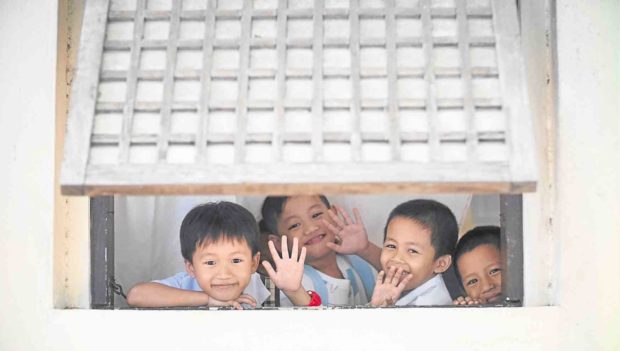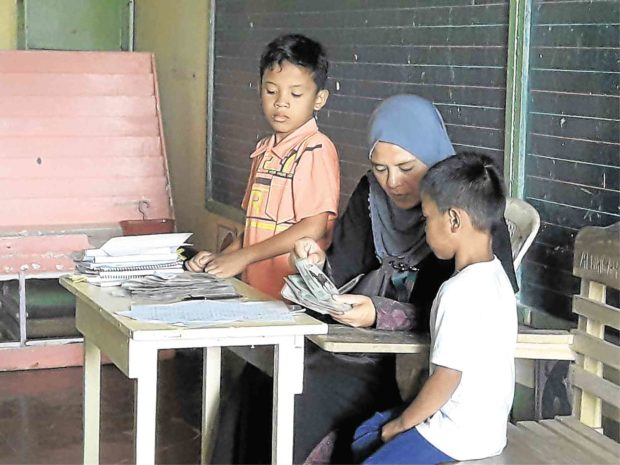Enrollment drops as residents cope with Boracay shutdown

FIRST DAY HIGH Grade 1 pupils at Albay Central School in Legazpi City relish their first day of classes as they look for their parents at the school grounds. —MARK ALVIC ESPLANA
As expected, enrollment dropped on Boracay Island this school year, after the closure of the resort island in Aklan province to tourists cost residents jobs and livelihood.
The island’s three elementary schools took in 3,882 students this year, down from the 4,643 who attended classes last year, according to Jessie Flores, Department of Education (DepEd) Malay district supervisor.
Many workers had left the island since the start of its six-month closure for rehabilitation on April 26.
Many residents said they were transferring their children to the Aklan mainland because of the economic difficulties on the island.
At Balabag Elementary School, enrollment went down to 1,328 from 1,756 last year. Enrollment at Manoc-Manoc Elementary School also dropped from 2,111 last year to 1,821.
Article continues after this advertisementAt Yapak Elementary School, enrollment reached 733, which is 43 students less than last school year’s 776.
Article continues after this advertisementThe number of high school students also dropped from 2,891 last year to 2,667.
At Boracay National High School, enrollment reached 1,049, down from 1,122 last year.
At Lamberto Tirol National High School, enrollment also went down to 484, from 534 last year.
From 1,235 students last school year, enrollment at Manoc-Manoc National High School reached 1,134 this year.
Enrollment figures usually increase an average of 20 percent yearly, according to Flores.
Visayas
In Western Visayas region, two million students went back to school on Monday, according to Victor de Gracia, DepEd
assistant regional director.
Except for the cities of Bacolod and Iloilo, classroom sizes had been kept to 40 to 50 students, he said.
In Tacloban City, families had transferred to the northern part of the city after their houses were destroyed by supertyphoon “Yolanda.”
At San Fernando Central School (SFCS), enrollment was expected to drop by 70 percent, according to school principal, Filitia Waniwan.
SFCS is one of the biggest elementary schools in the city, which served 1,504 students last year. On Monday, 1,122 students attended classes.
At Salvacion Elementary School in northern Tacloban, 490 students attended classes, said its principal, Lily Dumas.

SCHOOL SERVICE Students from island villages of Dagupan City use a banca to cross Calmay River so they can attend classes on the mainland. —WILLIE LOMIBAO
The city schools division reported that about 3,000
students were expected to enroll in schools in towns where they resettled after Yolanda’s onslaught.
Thelma Quitalig, city schools division superintendent, said 88 temporary classrooms were built to address the lack of classrooms.
The DepEd said it would need 4,100 teachers to fill up vacancies for the new school year in Eastern Visayas.
The vacancies were for 2,334 junior high school teachers, 1,780 kindergarten and elementary teachers, and 10 senior high school teachers in Samar, Eastern Visayas, Southern Leyte, Leyte, Biliran and Northern Samar.
Mindanao
In Mindanao, pupils at the Dumagoc Elementary School in Pagadian City attended classes in shifts on Monday as nine of its 15 classrooms were gutted by a fire on May 16.
Edmar Samson, school principal, asked the DepEd to allow pupils to borrow chairs from nearby schools. He also asked for donations to buy school supplies and additional chairs.
At Tiguma Elementary School, the repair of nine classrooms was scheduled to be completed in August so teachers had to merge some classes, according to principal Jessevic Boloron.
In Southern Luzon, some of the 1.7 million students who trooped to elementary and high schools in Bicol region did not have enough classrooms and facilities.
About 200 students of Ligao National High School started classes at the gymnasium, occupying every space, including the stage, as a school building inside the campus was still being built.
In Legazpi City, nine schools also implemented classroom shifts due to incomplete school buildings, said Santi Araña, Legazpi schools division spokesperson.
Shifts
Ibalon Central School, the second largest grade school in the city, scheduled three shifts due to the unfinished 19 classrooms, said Elizabeth Lara, school principal.
Some schools in Bicol also reported chair shortages, due to an increase in students, said Mayflor Marie Jumamil, spokesperson for the DepEd Bicol office.
In Ilocos Norte province, schools opened for more than 85,000 students, with isolated cases of overcrowding and classrooms still being repaired.
Classroom-pupil ratio
Last year, elementary schools operated with a classroom-pupil ratio of 1:36 or 36 pupils were accommodated in a classroom, and a teacher-pupil ratio of 1:43 or 43 pupils for every teacher.
In public high schools, a classroom accommodated 32 students, while a teacher handled 26 students.
At Burgos Agro-Industrial School in Burgos town, a teacher, Gladys Garcia, said five students returned to school under DepEd’s Balik Aral program, a special curriculum for out-of-school youth. —Reports from Nestor Burgos Jr., Leah Agonoy, Joey Gabieta, Leo Udtohan, Villamor Visaya Jr, Leilanie Adriano, Michael Jaucian, Mar Arguelles and Ma. April Mier
